7.01.2019
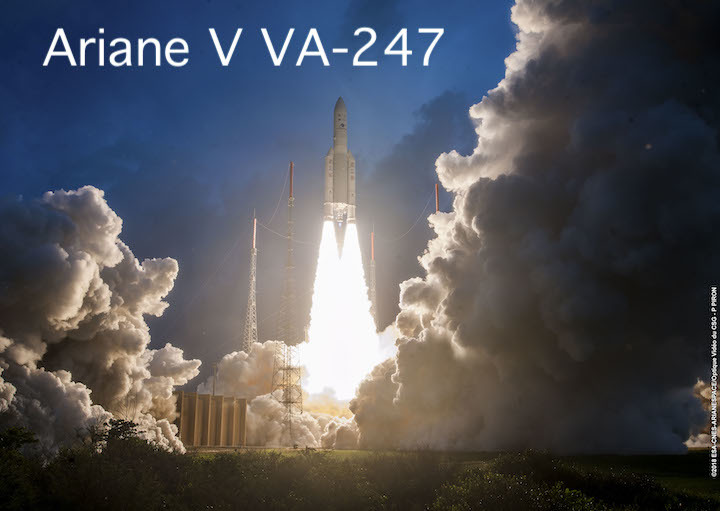
It’s a new year at the Spaceport in French Guiana, which welcomed on Jan 4 the first of two satellite passengers for #Arianespace’s initial #Ariane5 flight in 2019! HS-4/SGS-1 will be launched Feb 5.
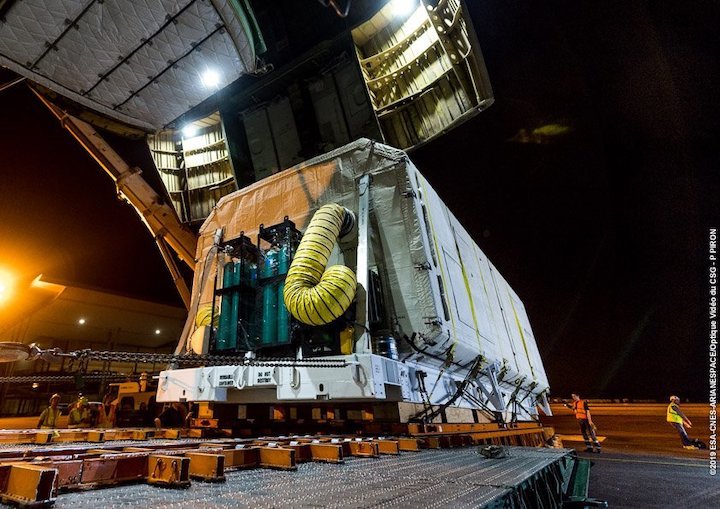
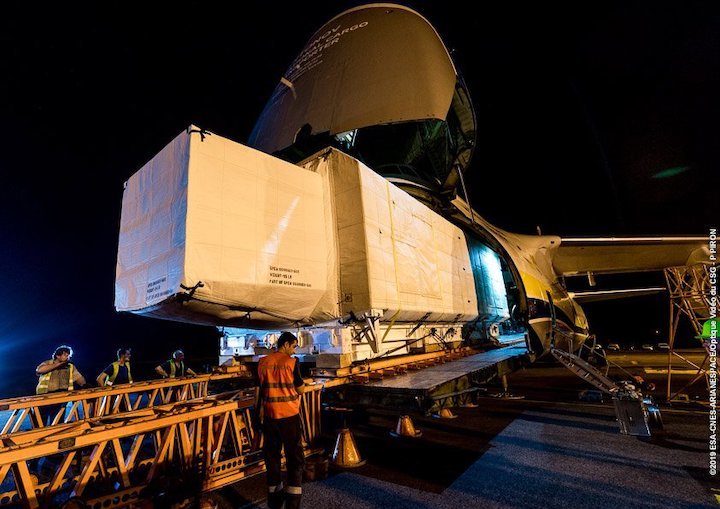
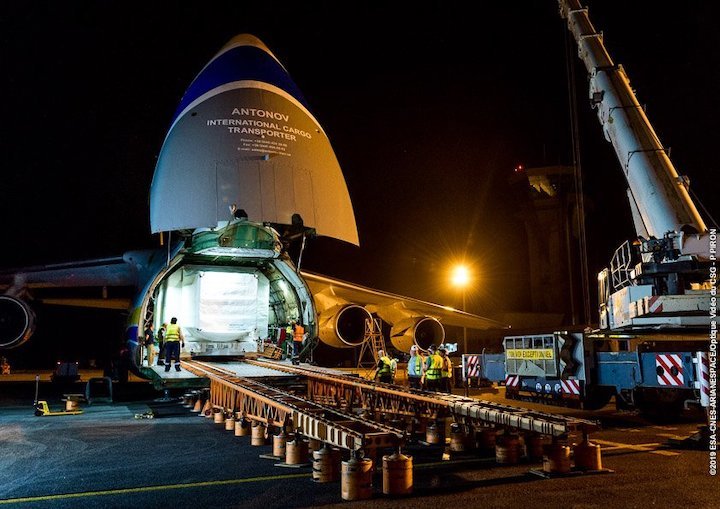
Quelle: arianespace
----
Update: 16.01.2019
.
Both satellites for Arianespace’s year-opening Ariane 5 launch are now in French Guiana
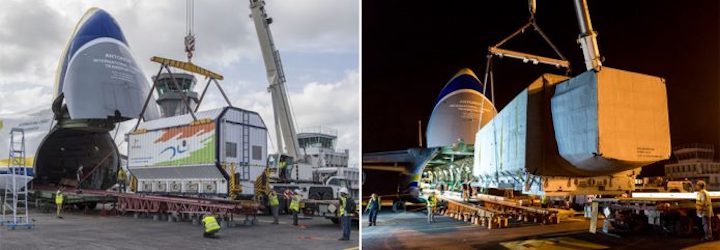
The GSAT-31 passenger for Arianespace Flight VA247 is unloaded from an Antonov An-124 cargo jetliner after arriving in French Guiana (photo at left). A similar process occurred several days earlier with the touchdown of its co-passenger for the upcoming Ariane 5 mission, Saudi Geostationary Satellite 1/Hellas Sat 4 (photo, right).
Building on Arianespace’s operational success in 2018, payload preparations for the company’s first flight in the new year are moving ahead with this week’s delivery of the mission’s second satellite, GSAT-31, to French Guiana – joining the Saudi Geostationary Satellite 1/Hellas Sat 4 (HS-4/SGS-1), which arrived earlier in January.
This newly-delivered passenger for Ariane 5 was flown to South America aboard an Antonov An-124 cargo jetliner, which landed at Félix Eboué Airport near the French Guiana capital city of Cayenne. After the unloading process, the protective container with GSAT-31 was readied for transportation by road to the Spaceport to begin payload processing. Its HS-4/SGS-1 co-passenger for the upcoming Ariane 5 mission underwent these same procedures following its own delivery on January 4.
Designated Flight VA247 in Arianespace’s numbering system, the year-opening Ariane 5 flight will lift off on February 5 – kicking off a fast-paced operational schedule that will include up to 12 missions using the company’s launcher family, with the heavy-lift Ariane 5 joined by the medium Soyuz and lightweight Vega.
Arianespace’s 2019 mission activity initiated by Flight VA247 will build on the company’s 11 launches last year, which placed nearly 57 metric tons into orbit for 13 different customers. In parallel, Arianespace will continue preparation activity during 2019 for the introduction of its next-generation launch vehicles: Vega C and Ariane 6.
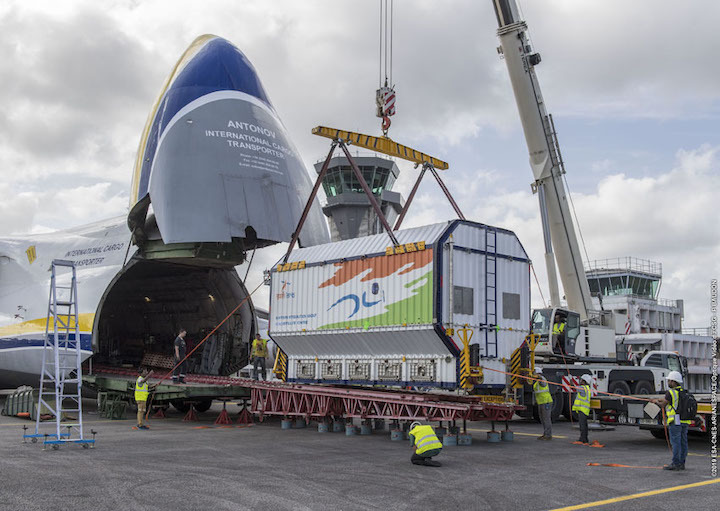
Quelle: arianespace
----
Update: 24.01.2019
.
OneWeb's first satellites arrive in Kourou, French Guiana in preparation for the first OneWeb launch on February 19, 2019
TOULOUSE, France, Jan. 22, 2019 /PRNewswire/ -- OneWeb, a global communications company with a mission to provide internet to everyone, everywhere through a global satellite constellation, announced that its first satellites have successfully arrived in Kourou, French Guiana as the company prepares for its first launch on February 19th.
This achievement demonstrates the hard work and commitment of industry partners as OneWeb continues to make progress towards building the world's first global satellite communications network in space.
The satellites were manufactured by OneWeb Satellites, a joint venture between OneWeb and Airbus that brings combined expertise in communications, manufacturing, and space to develop ultra-high performance satellites through a revolutionary new advanced manufacturing process.
The six ultra-high performance satellites delivered today were built at OneWeb Satellites's state-of-the-art manufacturing facility in Toulouse. Future satellites will be built at both the Toulouse facility and at a second facility in Exploration Park, Florida which will be inaugurated in the coming months.
OneWeb is excited to be partnering with Arianespace for the first launch, scheduled for February 19th on a Soyuz rocket. With the first satellites of the constellation launched, OneWeb plans to launch more than 30 satellites at a time on a monthly basis starting later in 2019 and will begin customer demos in 2020 with full twenty-four-hour global coverage beginning in 2021.
"OneWeb has a bold vision to enable connectivity for everyone, everywhere. We have made tremendous progress in building our infrastructure on the ground, and the delivery of our first satellites brings us one step closer to our first launch and beginning to now build our system in space. One of many launches in 2019, we are excited to begin building our constellation and to see our services connecting people everywhere – by land, air, and sea," said OneWeb CEO Adrian Steckel.
Quelle: OneWeb
----
Update: 28.01.2019
.
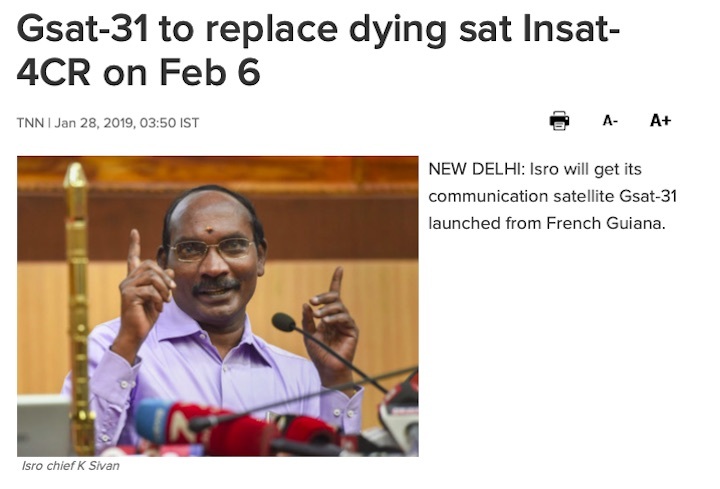
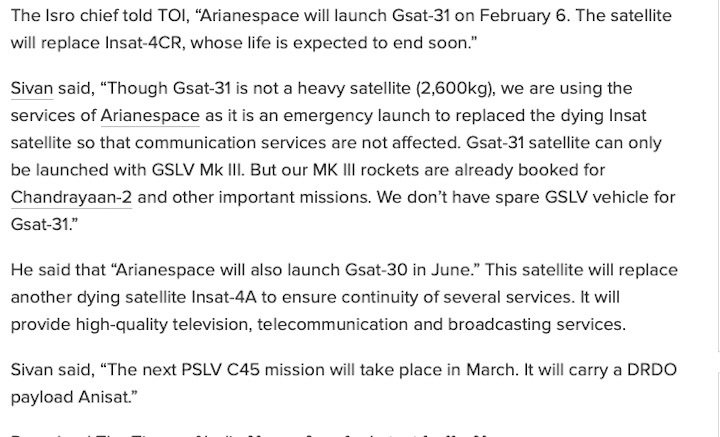
Quelle: The Times of India
----
Update: 2.02.2019
.
Indian To Launch 2,535 kg Satellite Onboard European Launch Vehicle
According to Arianespace, the launch of Ariane-5 (VA 247) is scheduled for 2:31 am India time on Wednesday.
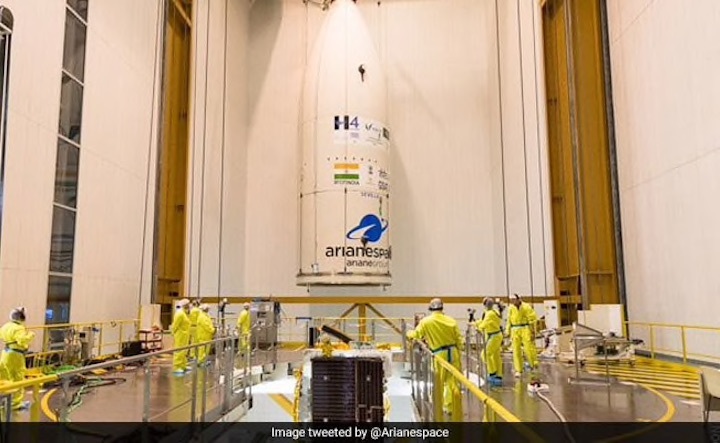
GSAT-31, will provide continuity to operational services on some of the in-orbit satellites, ISRO said.
India will launch its latest communication satellite onboard European launch services provider Arianespaces launch vehicle on February 6 from French Guiana, Indian Space Research Organisation said Friday.
According to Arianespace, the launch of Ariane-5 (VA 247) is scheduled for 2:31 am India time on Wednesday.
Weighing about 2,535 kg, the Indian satellite, GSAT-31, will provide continuity to operational services on some of the in-orbit satellites, ISRO said.
The satellite derives its heritage from ISROs earlier INSAT/GSAT satellite series, the space agency said, adding that it provides Indian mainland and island coverage.
GSAT-31 is the country's 40th communication satellite which is configured on ISRO''s enhanced ''I-2K Bus'', utilising the maximum "bus capabilities" of this type.
This satellite will augment the Ku-band transponder capacity in Geostationary Orbit, ISRO said.
With a mission life of around 15 years, GSAT-31 will be used for supporting VSAT networks, Television uplinks, Digital Satellite News Gathering, DTH-television services, cellular backhaul connectivity and many such applications.
It also provides wide beam coverage to facilitate communication over large oceanic region, comprising large parts of Arabian Sea, Bay of Bengal and Indian Ocean, using a wide band transponder.
According to ISRO, two Ku-band beacon downlink signals are transmitted for ground tracking purpose.
Saudi Geostationary Satellite 1/Hellas Sat 4 will be the co-passenger of GSAT-31 during the launch, Arianespace said.
Comprising two payloads, Saudi Geostationary Satellite 1/Hellas Sat 4, also called HS- 4/SGS-1, is a geostationary condosat for KACST (King Abdulaziz City for Science and Technology Saudi Arabia) and Hellas Sat (Greece Cyprus).
It will provide telecommunication capabilities, including television, Internet, telephone and secure communications in the Middle East, South Africa and Europe, Arianespace said on its website.
GSAT-30 is another geostationary satellite to be lofted soon by Arianespace.
Since the launch of Indias APPLE experimental satellite on Ariane Flight L03 in 1981, Arianespace has orbited 22 satellites and signed 24 launch contracts with the Indian space agency, it said.
Quelle: NDTV
----
Update: 3.02.2019
.
Payload integration is complete for Arianespace’s year-opening Ariane 5 flight
The Ariane 5 for Arianespace’s upcoming mission from the Spaceport in French Guiana is now fully-assembled following integration of its two passengers: Saudi Geostationary Satellite 1/Hellas Sat 4 (HS-4/SGS-1) and GSAT-31 – both of which will be delivered to geostationary orbit on a flight scheduled for February 5.

The Ariane 5 payload fairing containing Flight VA247’s HS-4/SGS-1 satellite passenger is readied to be lowered over the GSAT-31 spacecraft – which previously was installed atop Ariane 5’s central core.
Encapsulated in an ogive-shaped protective fairing, HS-4/SGS-1 has been positioned atop its GSAT-31 co-passenger – which was installed on the launcher’s cryogenic core stage during previous activity inside the Spaceport’s Final Assembly Building for Ariane 5.
These successive integration steps enable a new series of preparation milestones to begin. They include the tomorrow’s launch readiness review, which will be followed by Ariane 5’s February 4 rollout to the ELA-3 launch zone.
Liftoff is scheduled during a 61-min. launch window that opens February 5 at 6:01 p.m. local time in French Guiana, with the two spacecraft to be deployed on a flight lasting 42 minutes. Ariane 5 will deliver a total payload lift performance of more than 10,050 kg. during the mission.
Next week’s launch is designated Flight VA247, marking the 247th using an Ariane family vehicle since this European series of launchers entered service in 1979. It kicks off another busy year of activity for Arianespace, which has the objective of performing as many as 12 missions during 2019 with its full launcher family – consisting of the heavy-lift Ariane 5, medium-lift Soyuz and lightweight Vega.
Enhanced communications
Saudi Geostationary Satellite 1/Hellas Sat 4 – to be deployed from Ariane 5’s upper payload slot – is a geostationary “condosat” for Saudi Arabia’s King Abdulaziz City for Science and Technology (KACST) and Greek-Cypriot satellite operator Hellas Sat. It was designed, assembled and integrated by Lockheed Martin Space, with a coverage area that includes Europe, South Africa and the Middle East.

India’s GSAT-31 satellite is shown after its integration on the Ariane 5 launcher for Flight VA247 during preparation activity in the Spaceport’s Final Assembly Building.
The Saudi Geostationary Satellite 1 communications payload will provide advanced Ka-band spot beam communications services for KACST, a government organization responsible for promoting science and technology in Saudi Arabia. The Hellas Sat 4 communications payload will deliver advanced Ku-band regional beam communications services for the Arabsat subsidiary.
Riding in Ariane 5’s lower payload position, GSAT-31 – which was designed and manufactured by the Indian Space Research Organisation (ISRO) – will provide Ku-band communications services from geostationary orbit, helping “bridge the digital divide” with coverage across the Indian subcontinent.
- Larger versions of the photos above are available in the Gallery.
Launch window for Flight VA247:
| French Guiana | UTC | Athens | Riyadh | Bangalore |
| From 6:01 PM to 7:02 PM on Feb. 5 |
From 21:01 to 22:02 on Feb. 5 |
From 11:01 PM to 12:02 AM on Feb. 5-6 |
From 12:01 AM to 1:02 AM on Feb. 6 |
From 2:31 AM to 3:32 AM on Feb. 6 |
For its first launch of 2019, Arianespace will orbit two telecommunications satellites using an Ariane 5 from the Guiana Space Center: Saudi Geostationary Satellite 1/Hellas Sat 4, a condosat for KACST (and Hellas Sat; along with GSAT-31 for the Indian Space Research Organisation (ISRO).
Through this 103rd Ariane 5 mission – the 70th with an Ariane 5 ECA version – Arianespace confirms its leadership in the geostationary launch services market segment.

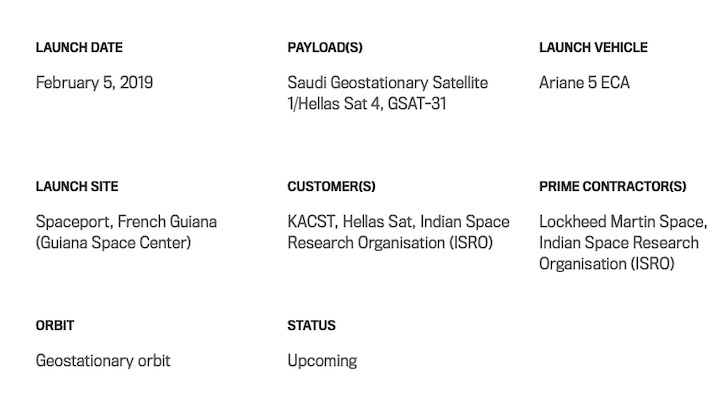

Quelle: arianespace
----
Update: 5.02.2019
.
Ariane 5 reaches the launch zone for Arianespace’s year-opening mission
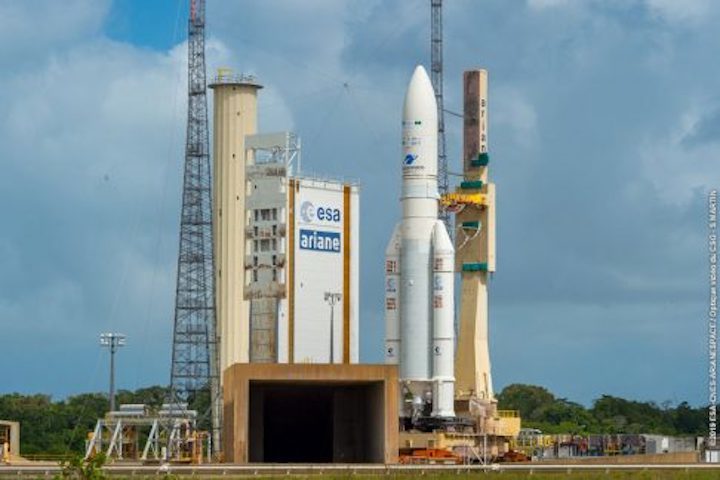
Ariane 5 nears completion of its transfer from the Spaceport’s Final Assembly Building to the ELA-3 launch zone, from which it will lift off on February 5.
The Ariane 5 for Arianespace’s Flight VA247 has reached the launch zone in French Guiana, positioning this vehicle for tomorrow’s dual-payload mission with Saudi Geostationary Satellite 1/Hellas Sat 4 (HS-4/SGS-1) and GSAT-31.
Riding atop a mobile launch table, Ariane 5 today completed its transfer from the Spaceport’s Final Assembly Building – where its two passengers were integrated – to the dedicated ELA-3 launch complex. This paves the way for tomorrow’s liftoff, which is planned during a 61-min. launch window that opens February 5 at 6:01 p.m. local time in French Guiana.
Today’s rollout from the Spaceport’s Final Assembly Building marked one of the final milestones in preparations for Flight VA247, which will kick off Arianespace’s 2019 launch activity. The company is planning up to 12 missions this year using the heavy-lift Ariane 5, medium-lift Soyuz and lightweight Vega.
A dual-payload deployment
Flight VA247 will be carrying a payload estimated at 10,018 kg. This total factors in the two satellite passengers’ combined liftoff mass, as well as hardware for Ariane 5’s dual-payload deployment system.
Riding in Ariane 5’s upper position, HS-4/SGS-1 is to be released first in the flight sequence, with its separation occurring 27 minutes after liftoff. Built by Lockheed Martin Space, it is a geostationary “condosat” for Saudi Arabia’s King Abdulaziz City for Science and Technology (KACST) and Greek-Cypriot satellite operator Hellas Sat, an Arabsat subsidiary.
Completing the mission will be the deployment of Ariane 5’s lower passenger, GSAT-31, which will occur 42 minutes after the flight begins. This spacecraft was designed and manufactured by the Indian Space Research Organisation (ISRO) to reduce the digital divide in India.
Launch window for Flight VA247:
| French Guiana | UTC | Athens | Riyadh | Bangalore |
| From 6:01 PM to 7:02 PM on Feb. 5 |
From 21:01 to 22:02 on Feb. 5 |
From 11:01 PM to 12:02 AM on Feb. 5-6 |
From 12:01 AM to 1:02 AM on Feb. 6 |
From 2:31 AM to 3:32 AM on Feb. 6 |
Quelle: arianespace
++++
LIVE Launch Frams Ariane-V-VA-247
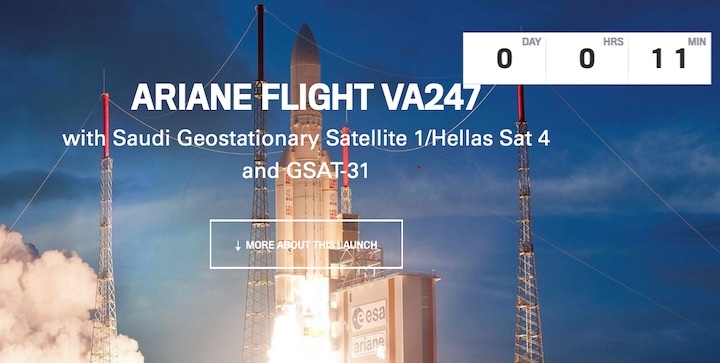
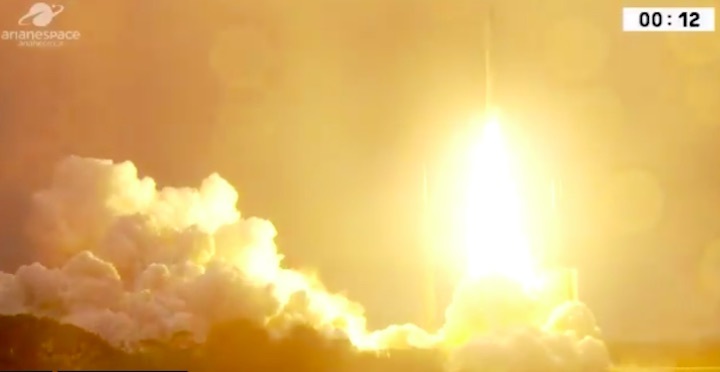
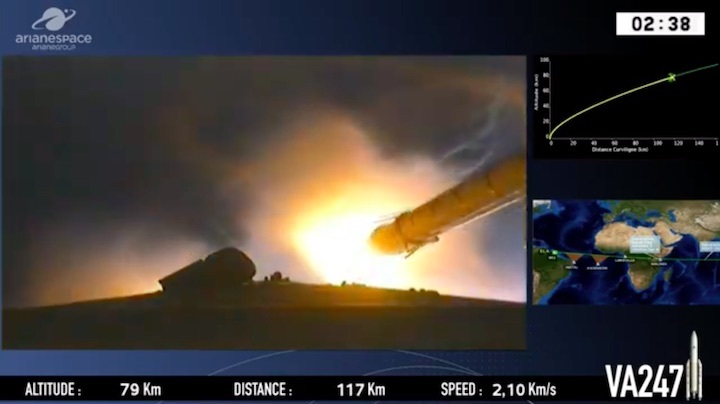
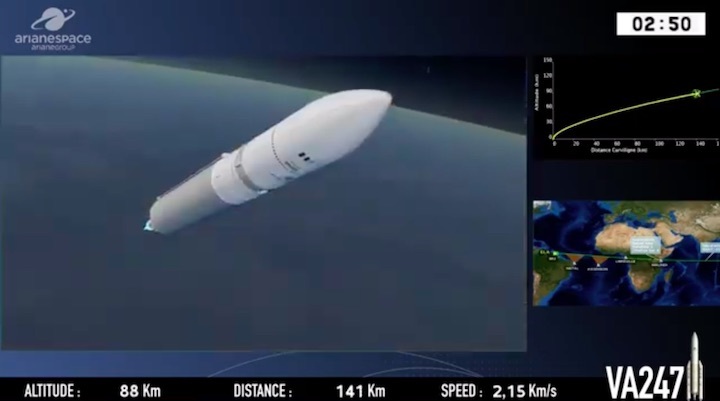
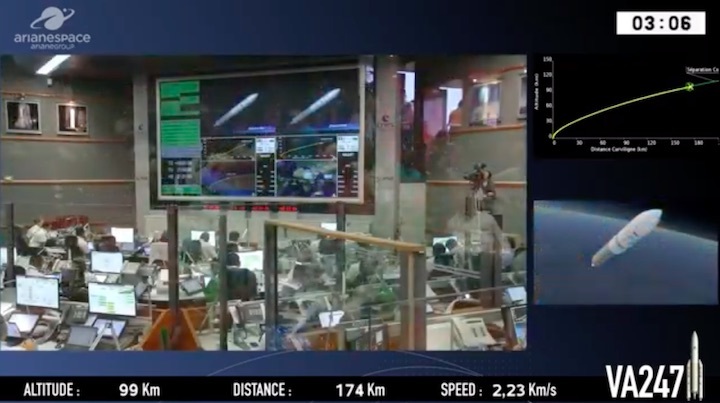
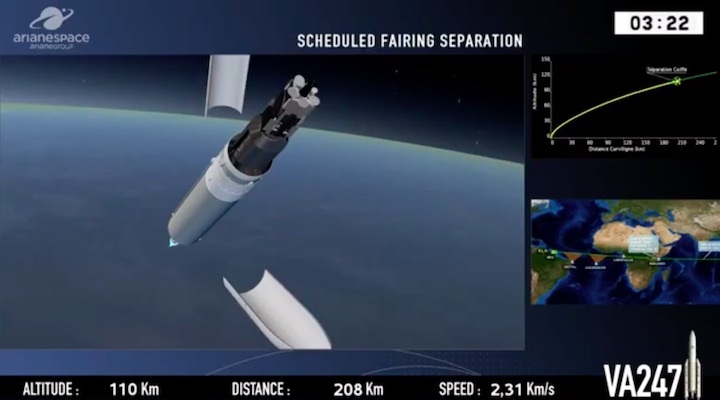
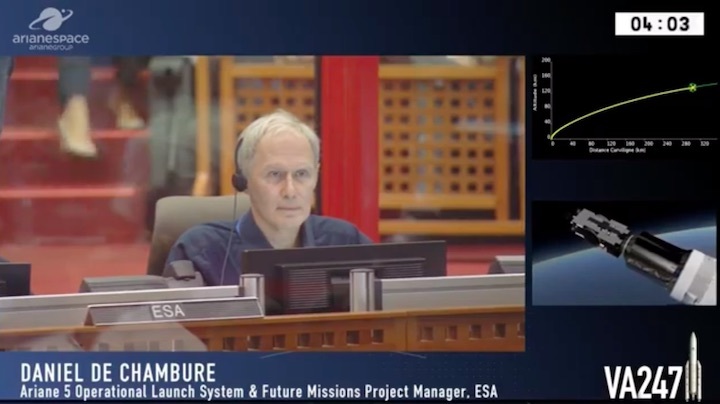
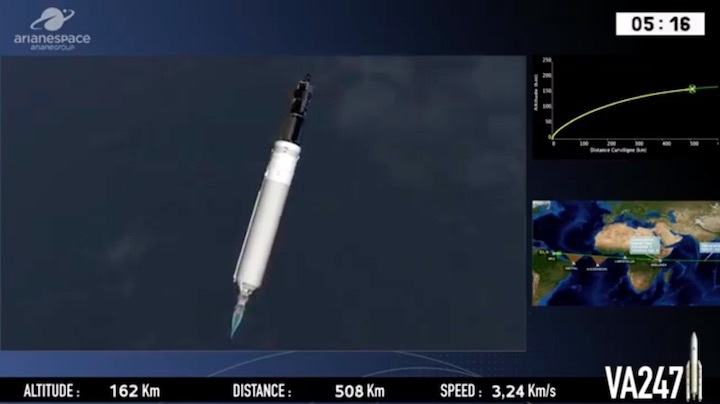
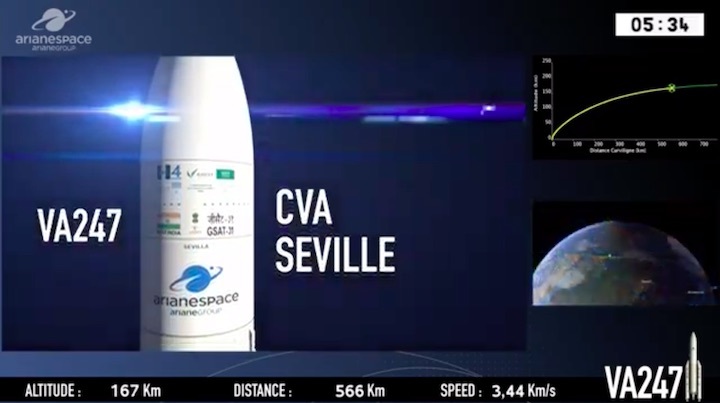
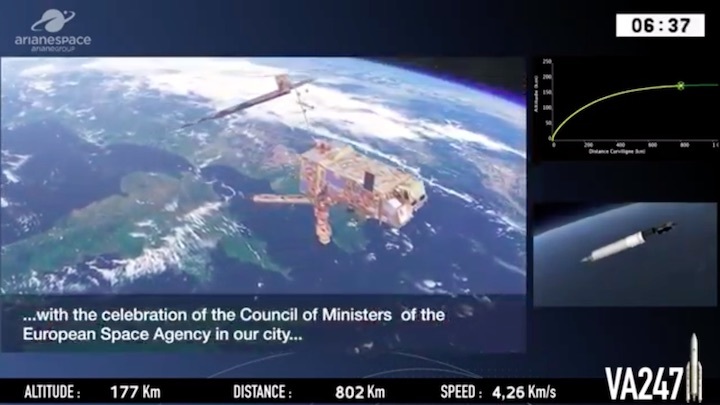
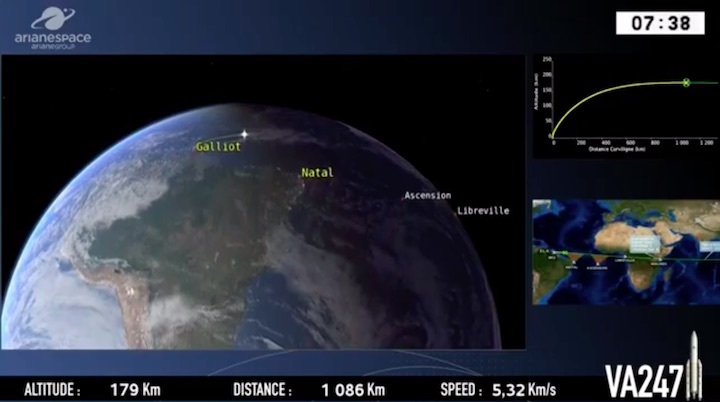
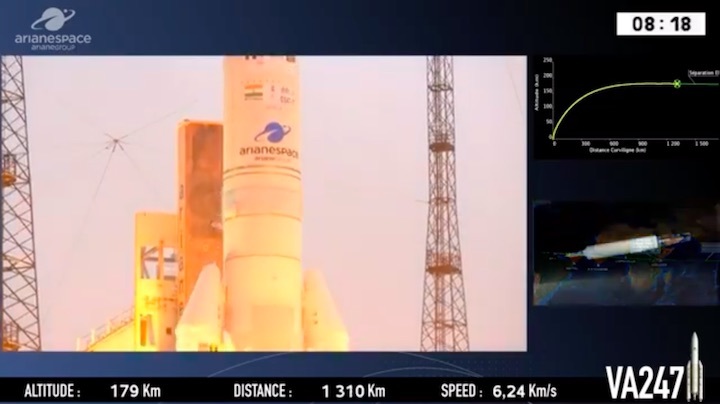
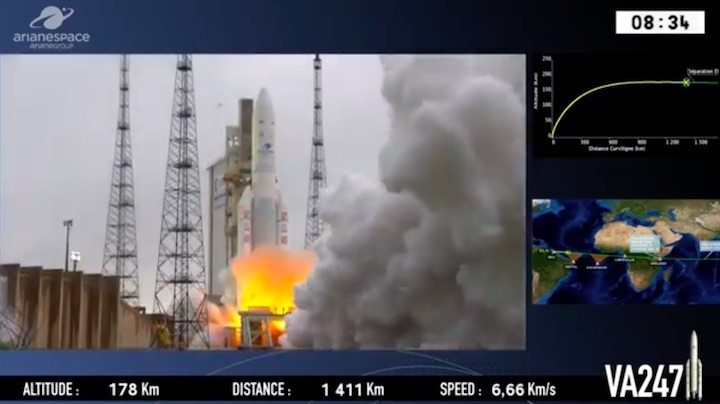
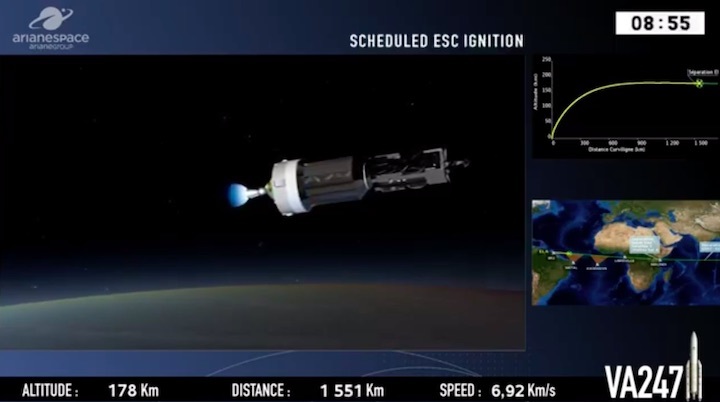
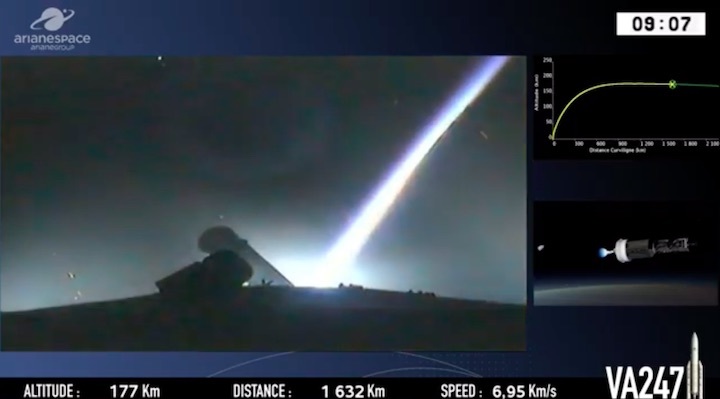
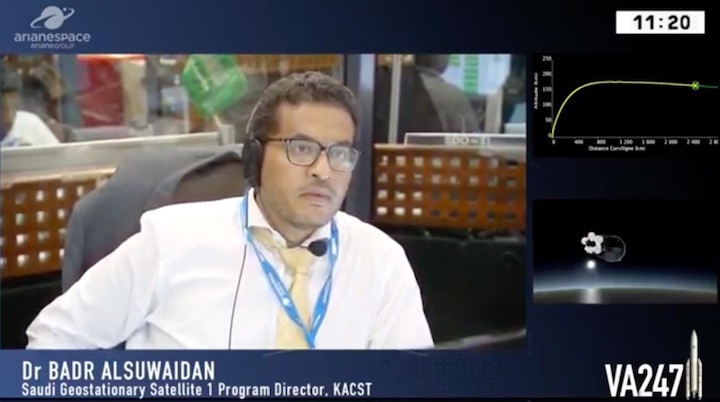
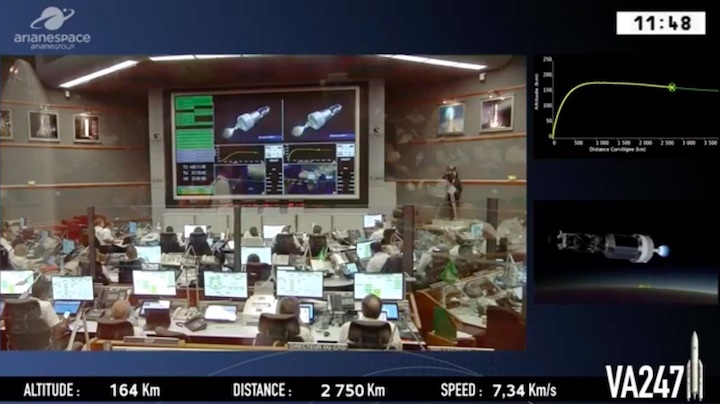
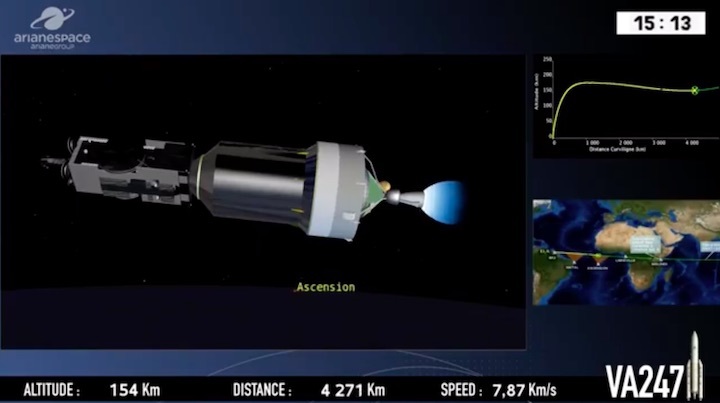
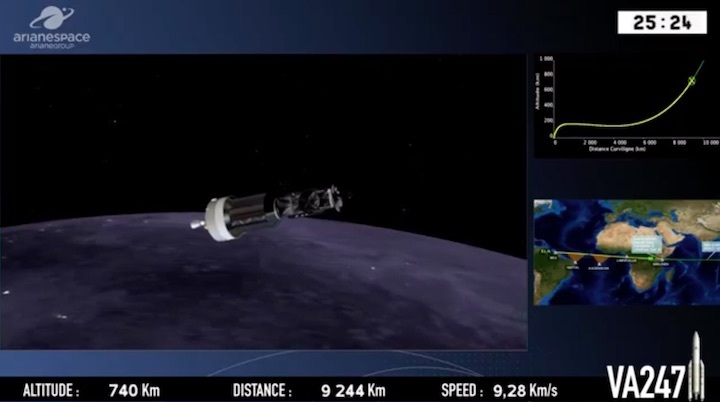
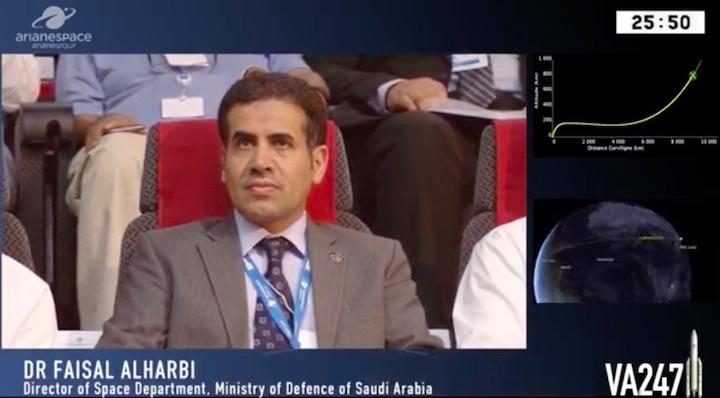

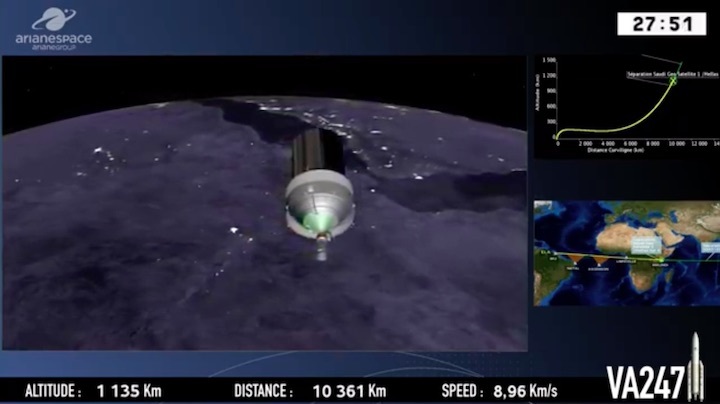
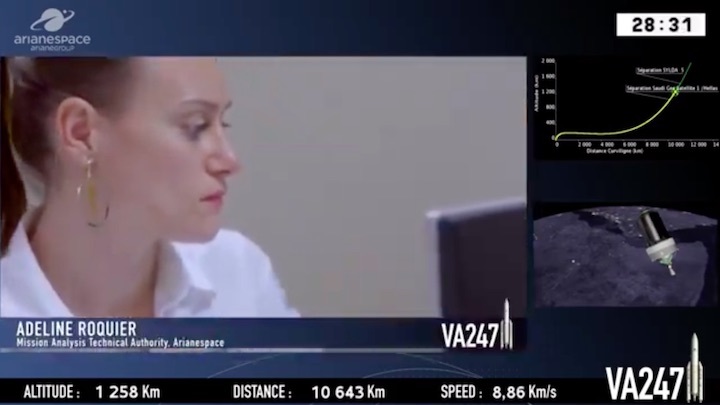
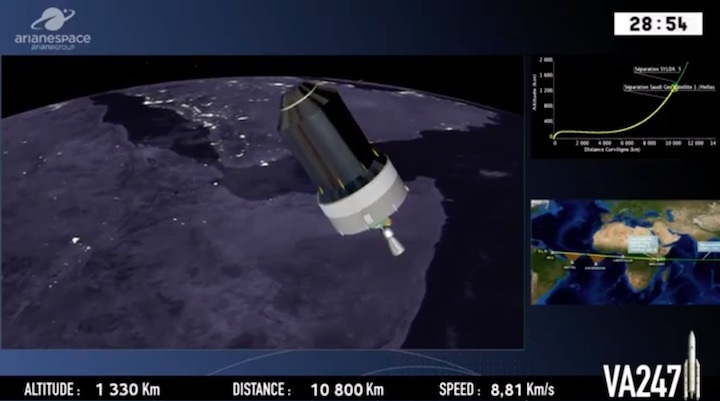
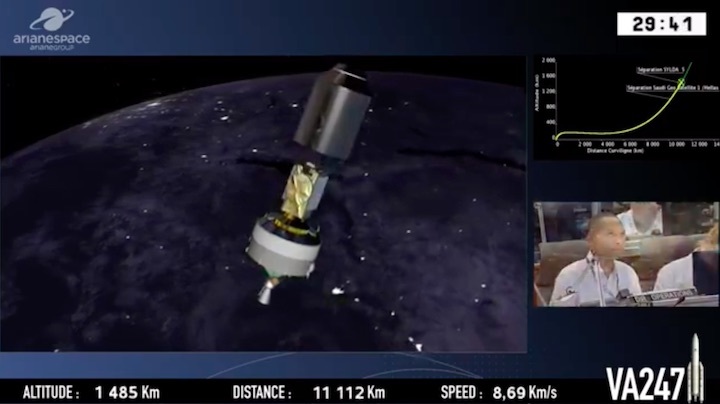
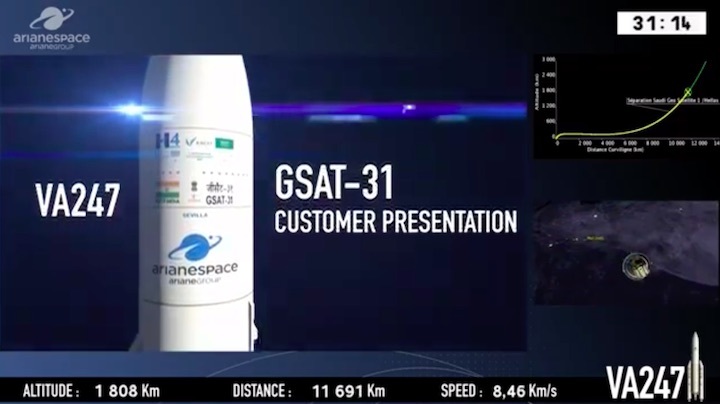
Quelle: arianespace
----
Update: 6.02.2019
.
ISRO to launch 40th communication satellite
ISRO is all set to launch its 40th communication satellite GSAT-31 on Feb 6.
GSAT-31 is scheduled for launch onboard Ariane-5 launch vehicle (va 247) from Kourou, French Guiana.
GSAT-31 is configured on ISRO's enhanced i-2K bus structure to provide communications services from geostationary orbit in Ku-band for over 15 years.
Weighing 2,535 kg, GSAT-31 will be used for supporting VSAT networks, television uplinks, digital satellite news gathering, DTH television services, cellular back haul connectivity and many such applications.
GSAT-31 will also facilitate communication over large oceanic regions comprising arabian sea, the Bay of Bengal and the Indian Ocean.
Ariane-5 launch vehicle will also carry Saudi geostationary satellite 1/hellas SAT 4 (Hs-4/Sgs-1).
It will provide telecommunications capabilities, including television, internet, telephone and secure communications in the Middle East, South Africa and Europe.
Hs-4/Sgs-1 weighs 6,495 kg and will have a design life of more than 15 years.A dual-passenger success: Ariane 5 delivers on Arianespace’s first launch of the year
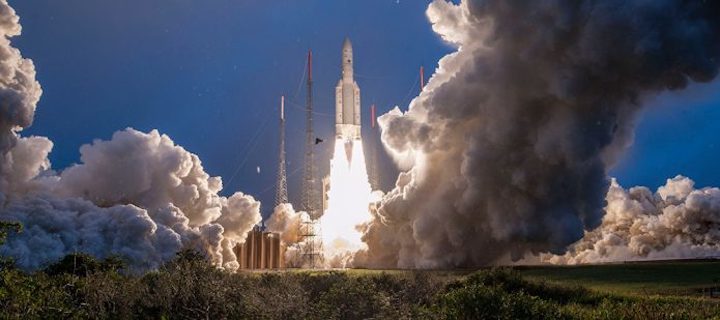
Arianespace opened its 2019 mission activity by successfully orbiting a pair of telecommunications spacecraft – Saudi Geostationary Satellite 1/Hellas Sat 4 (HS-4/SGS-1) and GSAT-31 – using the company’s workhorse Ariane 5 launch vehicle.
Today’s flight to geostationary orbit, performed from the Spaceport in French Guiana, delivered a payload lift performance estimated at 10,018 kg. – which included the two spacecraft, along with the dispenser system and integration hardware in Ariane 5’s dual-passenger configuration.
Arianespace CEO Stéphane Israël confirmed the success in post-launch comments from the Spaceport’s Jupiter control room. “For the first Ariane 5 launch of the year, our heavyweight vehicle has once more performed flawlessly,” he said. “Congratulations to all!”
“Condosat” capabilities
Deployed first in the flight sequence 27 minutes after liftoff, HS-4/SGS-1 is a geostationary “condosat” for Saudi Arabia’s King Abdulaziz City for Science and Technology (KACST) and Greek-Cypriot satellite operator Hellas Sat, an Arabsat subsidiary. Designed, assembled and integrated by Lockheed Martin Space, HS-4/SGS-1 will operate from an orbital position of 39 deg. East, with a coverage area that includes Europe, South Africa and the Middle East.
The Arianespace CEO acknowledged the direct customer for HS-4/SGS-1, Arabsat, and called this 11th Arianespace mission at the service of the Riyadh, Saudi Arabia-based telecommunications operator a “new bright success.”
The Saudi Geostationary Satellite 1 communications payload will provide advanced Ka-band spot beam communications services for KACST, a government organization responsible for promoting science and technology in Saudi Arabia. The Hellas Sat 4 communications payload will deliver advanced Ku-band regional beam communications services for the Arabsat subsidiary.
23 launches and counting for ISRO
GSAT-31 was carried in Ariane 5’s lower payload position and released second in the sequence for today’s mission, which is designated Flight VA247 in Arianespace’s numbering system – representing the 247th launch of an Ariane-series launch vehicle.
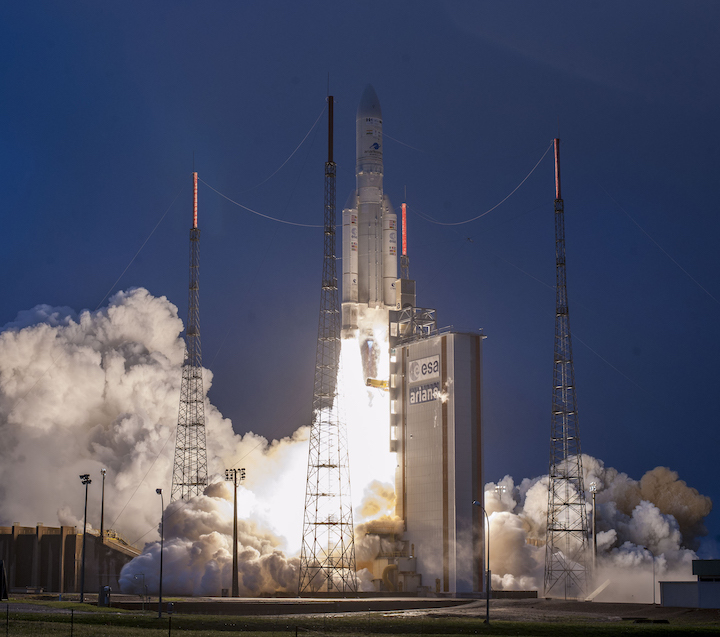
The spacecraft was designed and manufactured by the Indian Space Research Organisation (ISRO) and will provide Ku-band communications services from an orbital slot at 48 deg. East, helping “bridge the digital divide” with coverage across the Indian subcontinent.
Israël noted that GSAT-31 was the 23rd ISRO satellite orbited by Arianespace and Ariane-series launchers, tracing the relationship back to India’s APPLE small experimental communications spacecraft, lofted in 1981 by an Ariane 1 version. He added: “Arianespace is honored ISRO has entrusted Ariane 5 for two launches back-to-back, with the last Ariane 5 of 2018 launching GSAT-11, and today the first one of the year 2019, which orbited GSAT-31!”
With today’s success, Arianespace kicks off a busy launch schedule in 2019 – which targets up to 12 missions from the Spaceport with the heavyweight Ariane 5, medium-lift Soyuz and lightweight Vega.
Quelle: arianespace
